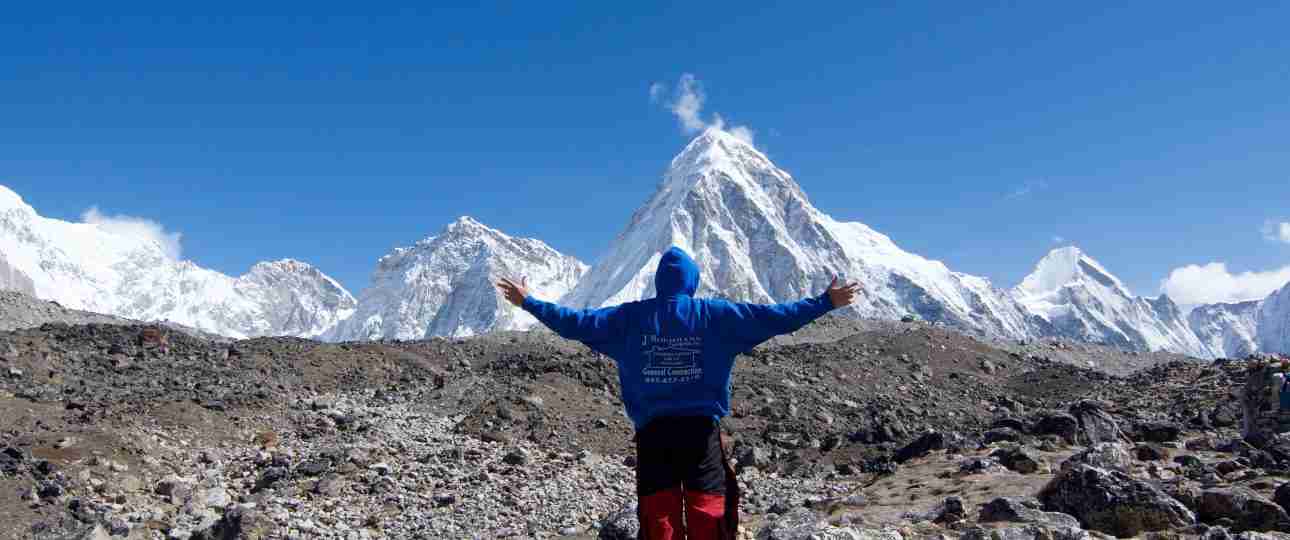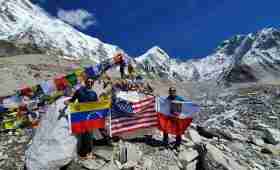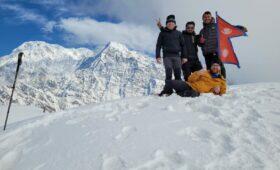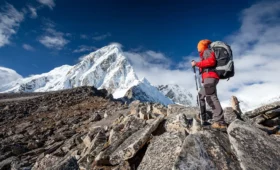Do you want to trek to Everest Base Camp? In this post, I will help you get answers to all your questions about how to get to Everest Base Camp.
If you want to climb to Everest Base Camp in Nepal, we recommend that you do it in 12 days, making it a total of 14 days, with 12 days for the trekking part and 2 days for Kathmandu. During the trek, you should take 12 days with two acclimatization/rest days at Namche Bazaar and Dingboche. This way, you are more likely to avoid Altitude Mountain Sickness (AMS) and trek to Everest Base Camp safely. Making it shorter and doing it in less than 12 days is not only bad for your health but also makes your overall journey tiring and unpleasant. It is advisable to take more time to get to Everest Base Camp rather than returning from the middle if you get sick while planning to do it without proper acclimatization. Let me show you the fundamentals of the Everest Base Camp trek and the right itinerary, and everything you need to do this trek in the best possible way.
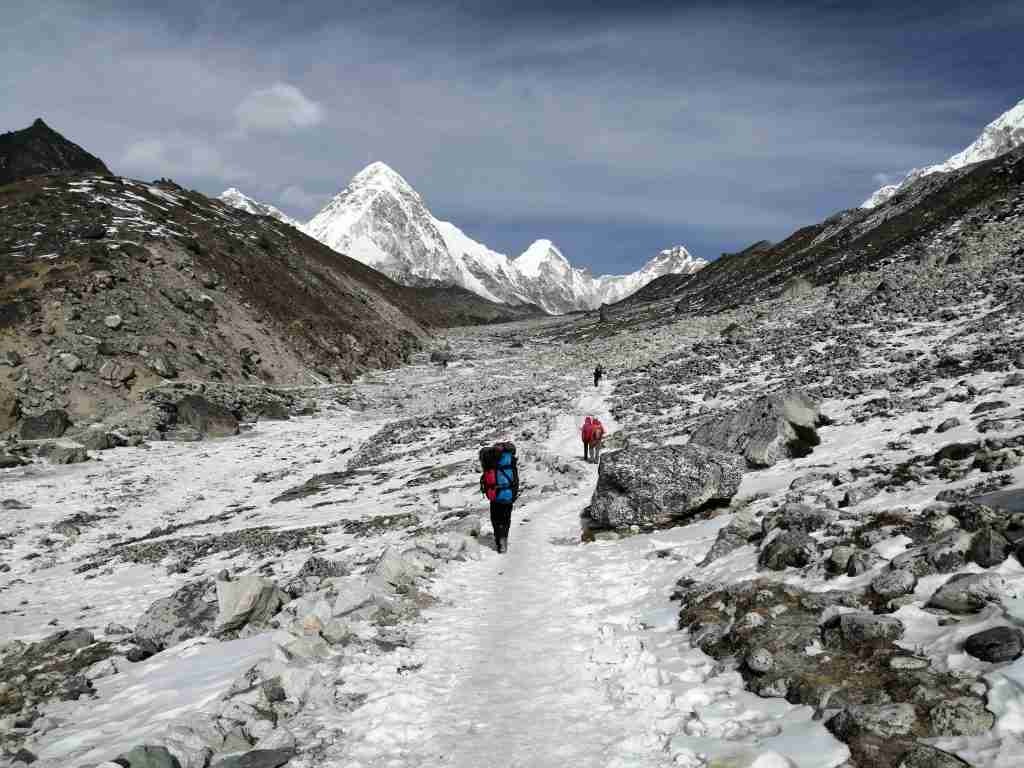
Mount Everest, also known as Chomolungma or the Goddess Mother of the World in the Tibetan language, stands as the highest point on Earth and tops the bucket list of many. Numerous movies and books have been created about this mighty giant, and for hundreds of years, mankind has been trying to understand and control the greatness of Mount Everest. However, in Nepal, the mystic activity of the Himalayas cannot be ignored. The Himalayas determine its fundamentals, topography, weather, and trade. Trekking is one of the main reasons people visit the Everest region, also known as the Khumbu region in Nepal. Even though some trekkers prefer other regions like Annapurna or Langtang for being more scenic, we can totally understand why the Everest Base Camp trek is on your bucket list. Come on, it’s Mount Everest! You definitely have to do it in your lifetime.
The Everest Base Camp trek is really popular among adventure seekers and has been done by many. However, sometimes, some of us misunderstand and underestimate the risks of altitude sickness and general safety in the mountain region of Khumbu. Being able to catch a glance of Mount Everest and trek to its base camp is all that matters for some, and they want to do it in 9 or even 8 days. And that is really pushing yourself into danger.
Table of Contents
- How to get to Everest base camp?
- What is the recommended and correct itinerary to reach Everest Base Camp?
- 1st Day: Kathmandu – (a 4-hour drive to Ramechap during peak season) – Lukla – Phakding – 4 hours trek, 30-minute flight.
- 2nd Day: Phakding – Namche Bazaar – 6 hours trek.
- 3rd Day: Acclimatization day in Namche Bazaar – about 4 to 5 hours total walking.
- 4th Day: Namche – Tyangboche – 5 hours trek.
- 5th Day: Tyangboche – Dingboche – 4 hours trek.
- 6th Day: Acclimatization : Dingboche – Nagartshang Peak – Dingboche – 4 hours trek.
- 7th Day: Dingboche – Lobuche (4950 m) – 5.5 hours trek.
- 8th Day: Lobuche – Gorakshep – Everest Base Camp – Gorakshep – 7 hours trek.
- 9th Day: Gorakshep – Kalapatthar – Gorakshep – Pheriche – 7 hours trek.
- 10th Day: Pheriche – Namche Bazaar – 6 hours trek.
- 11th Day: Namche – Lukla – 8 hours trek.
- 12th Day: Lukla – Kathmandu (to Ramechap during peak season) – 30 minutes flight.
- How safe is the Everest Base Camp trek?
- What is the best time to for the trek to Everest Base Camp?
- What permits do I need for the Everest Base Camp trek?
- How do I get in shape to get to Everest Base Camp?
- What are the health benefits of trekking to Everest Base Camp?
- How can I diagnose altitude sickness at Everest Base Camp?
- How can I prevent altitude sickness on the Everest Base Camp trek?
- From Kathmandu to Everest Base Camp – Flight to Lukla
- Why is Lukla flight diverted to Ramechap?
- What are the teahouses like at Everest Base Camp?
- What do I pack for the Everest Base Camp trek?
- At what altitude is Everest Base Camp located?
- Is it compulsory to trek to Everest Base Camp with a guide?
- Everest Base Camp trek price:
- How do I book the Everest Base Camp trek?
How to get to Everest base camp?
The 12-day standard trek to Everest Base Camp is a roughly 130 km round trip. Out of those 12 days, there are two acclimatization days at Namche and Dingboche. It takes 8 days to reach the base camp of Mount Everest and 4 days to return.
What is the recommended and correct itinerary to reach Everest Base Camp?
If you want to trek to Everest Base Camp the right way, you have to do it in 12 days. You don’t want to call your family from Nepal saying you had to be evacuated back to the capital from the mountains of Nepal. You can be as fit as a professional marathon runner or have all the clothing and gear you need, but altitude sickness can hit anyone; even those who have climbed Mount Everest itself need to acclimatize properly. Be smart, do proper research, and choose an itinerary of 12 days or even more. Below, we have outlined an itinerary that is based on a 12-day Everest Base Camp trek as part of the standard Everest Base Camp Trek that we run. Prepare your hiking boots and join Mosaic Adventure on this epic and exciting journey to the world-famous Everest Base Camp.
1st Day: Kathmandu – (a 4-hour drive to Ramechap during peak season) – Lukla – Phakding – 4 hours trek, 30-minute flight.
Early in the morning, you will board a thrilling flight to Tenzing Hillary Airport in Lukla and get a chance to view the Himalayas once you arrive at Lukla airport, known as one of “the world’s most dangerous airports.” If you are trekking during peak season, you will have to drive early in the morning to Ramechap to catch a flight to Lukla. After a short stop in Lukla, your trek to Everest Base Camp begins. You will start your journey through the Dudhkoshi River valley heading towards Cheplung. Right after crossing the suspension bridge over the Thadokoshi River, you will see Kusum Kangaroo Peak standing at an elevation of 6,367 meters. With gradual climbs towards Ghat and passing a stone ridge marked with Tibetan chanting of Om Mane Padme Hum, after a total of about 3 hours of walking, we will reach the beautiful Phakding village. We will be staying here tonight at a local teahouse.
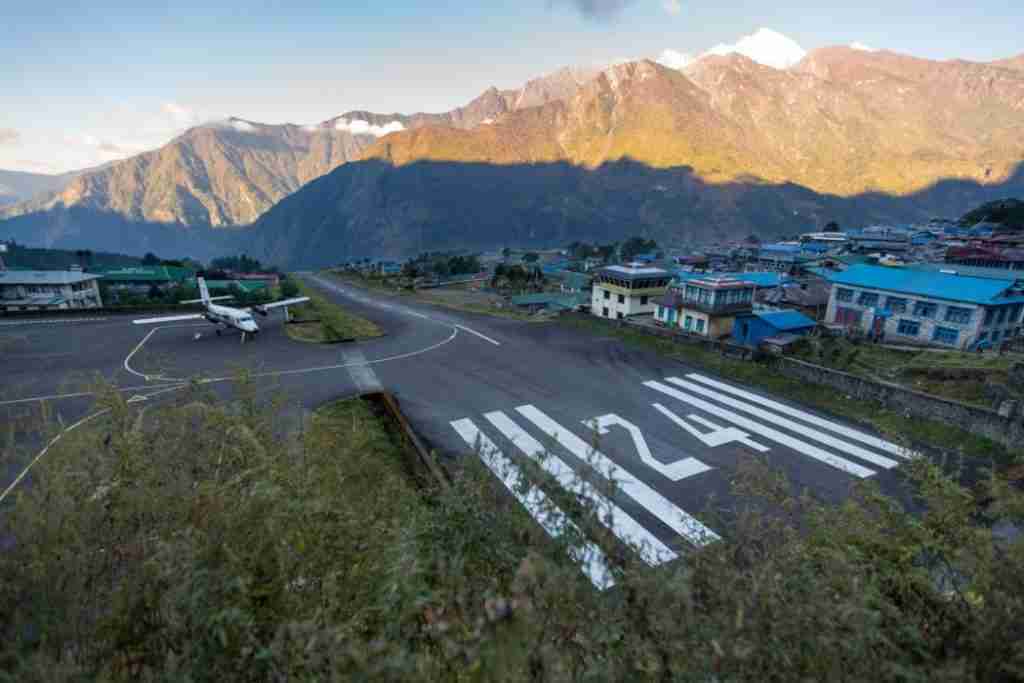
2nd Day: Phakding – Namche Bazaar – 6 hours trek.
Again we will start our second day walking through the valley of the Dudhkoshi River. While heading towards Namche Bazaar, we will cross five of those famous suspension bridges that you have only seen in pictures, decorated with Lungda (prayer flags). With gradual hiking upwards towards Namche Bazaar for almost two and a half hours, you will be able to catch a glimpse of Mount Everest for the first time. With a hard climb of roughly 6 hours, you will finally reach this famous town of Namche Bazaar, often known as the gateway to Everest.
3rd Day: Acclimatization day in Namche Bazaar – about 4 to 5 hours total walking.
This is our 1st day of acclimatization, and it is important for us to climb high and sleep low to adjust our bodies to the increasing altitude. We will be exploring the Khumjung/Khunde village along with a side trip to Syangboche, also known as the Everest View Hotel. In Khumjung, you will be able to see the Yeti skull in the monastery. On your return trip to the Everest View hotel, you can get an impressive view of the mountains and see Buddhist Chortens. Today, in general, you will get to see the peak of Mount Everest, Lhotse, and Ama Dablam.
4th Day: Namche – Tyangboche – 5 hours trek.
While heading toward Tyangboche on our fourth day, the trail gets in and out of a side valley, making it slightly up and down along the Kenjoma. Passing Mani stones, we then join the trail of Khumjung with an excellent view of Everest and Ama Dablam mountains. After this, we will pass through the small Sanasa village and descend before starting the steep climb towards the Tyangboche monastery. Once you reach Tyangboche, you are going to get a panoramic view of various mountains like Tawache, Kwangde, Everest, Nuptse, Thamseruku, Kangega. We will call it a day and stay overnight at Tyangboche, listening to mantras coming from the Tyangboche monastery.
5th Day: Tyangboche – Dingboche – 4 hours trek.
We start our day with a descent through a beautiful forest. We reach Pangboche village after crossing the Imja river. From there, the trail continues through grasslands and finally reaches our destination. The quiet Dingboche village is the place where we will spend our night with superb views of the mountains.
6th Day: Acclimatization : Dingboche – Nagartshang Peak – Dingboche – 4 hours trek.
This is our second acclimatization day doing a return trip to Nagartshang Peak. This peak is known by various names – Nagkart Tshang, Nagarjun, Nangar Joong, etc. Nagartshang Peak is one of the best viewpoints in the Everest region to get a glimpse of numerous Himalayan peaks. From the summit of Nagartsang, we can see Ama Dablam, Kangtega, Nuptse, Cho Oyu, Lhotse, Makalu, Taboche, etc. in their full glory.
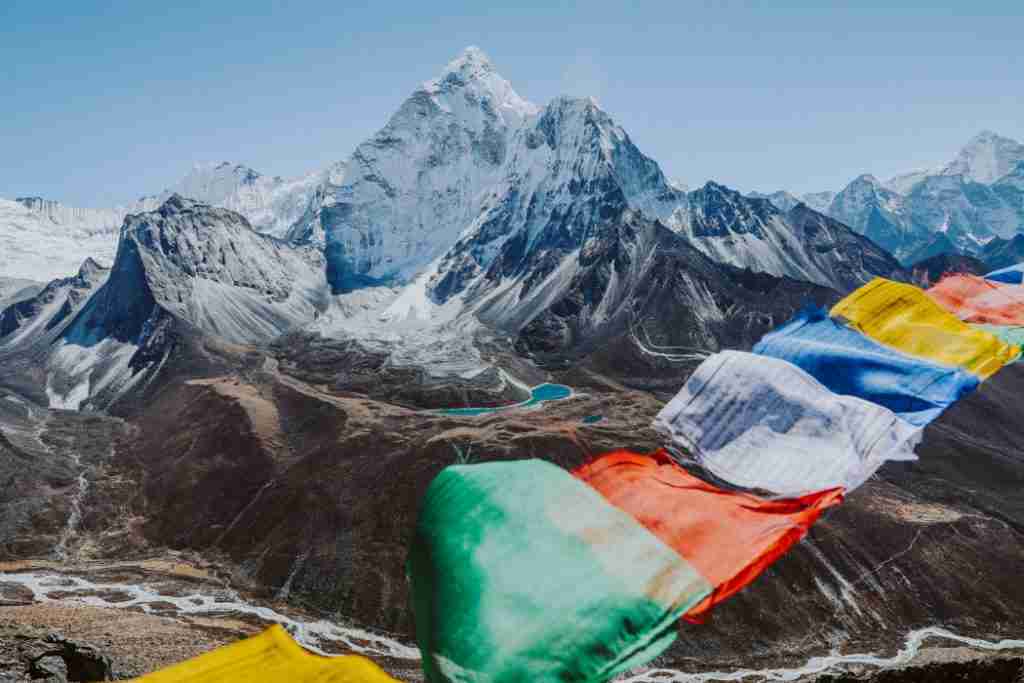
7th Day: Dingboche – Lobuche (4950 m) – 5.5 hours trek.
We will start another day with a climb towards Thukla, which is a gentle climb for about an hour and a half. After another trek of the same length and crossing the Thukla Pass, we will come to a memorial place that was made for those who died while attempting to climb the surrounding Himalayan peaks. As we head towards Lobuche, the mountains start to get closer. After exiting the valley of Pheriche village and descending further, we will reach Lobuche, the yak pasture.
8th Day: Lobuche – Gorakshep – Everest Base Camp – Gorakshep – 7 hours trek.
After hiking for about two hours, we will reach the last village of the Everest Region, Gorakshep. Our night stay will be in this place, but before calling it a day, we will make a return trip to Everest Base Camp. After having lunch at Gorakshep, leaving our belongings there, and carrying only light essentials in our daypacks, we will start our return trip to the dream destination, Everest Base Camp. Walking along the side of the famous Khumbu Glacier, we will finally reach EBC. After spending some time there, we will return to Gorakshep to spend the night. More details of this day are best experienced by yourself rather than described here :).

9th Day: Gorakshep – Kalapatthar – Gorakshep – Pheriche – 7 hours trek.
Early in the morning, before sunrise, we start our journey to climb Kalapatthar so that we can witness the sunrise over the Himalayas from the peak of Kalapatthar. The sunrise viewing over Kalapatthar is one of the highlights of the trek. After spending a short time at the top of Kalapatthar, we start tracking our trail back to Lukla. We stop for breakfast in Lukla before heading towards Pheriche. If everyone in the group is happy with the decision, we might further descend from Pheriche.
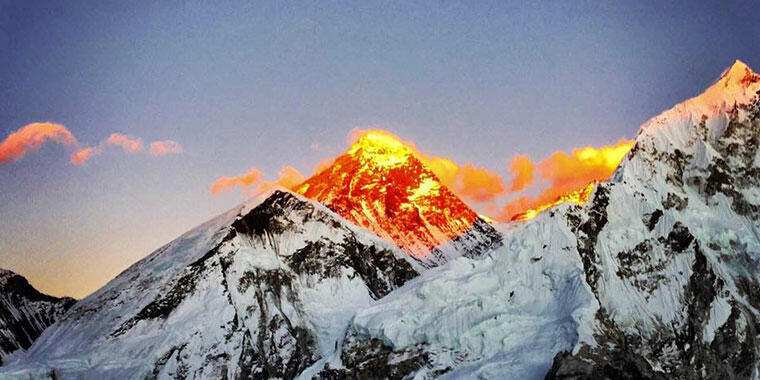
10th Day: Pheriche – Namche Bazaar – 6 hours trek.
We are now heading towards Namche Bazar, passing through the same villages of Deboche, Tyangboche, Phungi Thanga, etc. You can enjoy a “hot shower” here and then visit bars, bakeries, etc.
11th Day: Namche – Lukla – 8 hours trek.
The trail from Namche to Lukla is mostly downhill before it reaches the flat part. After crossing the Sagarmatha National Park entry gate, gather some energy to climb again to finally reach Lukla. This marks the end of the tiring yet epic journey to Everest Base Camp.
12th Day: Lukla – Kathmandu (to Ramechap during peak season) – 30 minutes flight.
We will leave Lukla early in the morning and finally be back in the capital city of Kathmandu. When you reach the hotel, you will be happy to see the smallest of things like properly running water, clean and well-closed rooms, hot water, proper oxygen, etc. You will spend one night in Kathmandu as part of the 14-day standard Everest Base Camp trek before flying home. You can add a night or two to the package to explore more of Kathmandu.

How safe is the Everest Base Camp trek?
Safety is one of the most important things to consider for us, and surely for you too. When it comes to high altitude treks like Everest Base Camp, we do not compromise on safety. You will be accompanied by a guide who was selected based on their professional knowledge, experience, and training. The Everest Base Camp trek is safe if you do it with proper preparation and go with an experienced guide assigned by a reputed tour operator.
Now, if you are thinking about safety considering crime on the trail, then you don’t have to worry. There isn’t anything to worry about, and the EBC trail is safe.
What is the best time to for the trek to Everest Base Camp?
Although we run this tour throughout the year, the best time to trek to Everest Base Camp is during spring and autumn. March to mid-June in spring and late September to early December in autumn is considered the best time for the EBC trek. Everest Base Camp Trek in September has a mixed nature of seasons, sometimes it can be like autumn and some times extended monsoon can affect some days.
What permits do I need for the Everest Base Camp trek?
Currently, you need the following permits for the trek to Everest Base Camp:
- Permit to enter Sagarmatha National Park.
- TIMS permit.
- Khumbu Pasang Lhamu Rural Municipality entry Permit.
All of these necessary permits are arranged by Mosaic Adventure.
How do I get in shape to get to Everest Base Camp?
If you don’t live in the Himalayas and are from low altitude countries, it will be difficult to prepare yourself for the altitude as you don’t get much higher than in Nepal. This is the reason why, unless you have already done high altitude treks earlier, there is no hundred percent preparation for any trek.
You are not climbing Everest itself and are not participating in high altitude marathon runs, so take it easy and follow these preparation guidelines for EBC.
What are the health benefits of trekking to Everest Base Camp?
Some of the health benefits of trekking include a lower risk of heart disease, better blood and sugar levels, and of course, it helps you to keep in shape. Once you’re ready to hit the trail, the benefits are even greater.
The benefits of trekking to Everest Base Camp include “nice views, fresh air, and the sounds and smells of nature.”
Trekking is a powerful cardio workout that can:
- Lower your risk of heart disease
- Improve your blood pressure and blood sugar levels
- Boost bone density, since walking is a weight-bearing exercise
- Build strength in your glutes, quadriceps, hamstrings, and the muscles in your hips and lower legs
- Strengthen your core
- Improve balance
- Help control your weight
- Boost your mood.
“Research shows that hiking has a positive impact on combating the symptoms of stress and anxiety,” says Gregory A. Miller, PhD, president of the American Hiking Society. “Being in nature is ingrained in our DNA, and we sometimes forget that.”
How can I diagnose altitude sickness at Everest Base Camp?
Symptoms of Acute Mountain Sickness become noticeable within a few hours of reaching any high altitude, including nausea, shortness of breath, headache, and inability to move. The feeling of fatigue will take away all the joy you have been feeling. You may have trouble sleeping, mostly feel dizzy and have a severe headache. You may lose balance, have trouble walking, and feel pressure in your chest. If the situation gets worse into HAPE (high altitude pulmonary edema) or HACE (high altitude cerebral edema), you may feel confused, short of breath when standing still, and you may not even be able to walk a little.
At higher altitudes, symptoms can become more severe. Guides know these symptoms and have the necessary training along with knowledge to treat them as per the symptoms immediately. Don’t wait until it’s too late. When you know the symptoms, talk to your guide and make things right immediately.
How can I prevent altitude sickness on the Everest Base Camp trek?
The general rules outlined below can/will help you prevent altitude sickness and can also help you recognize AMS symptoms.
Careful preparation back home:
It is recommended to get a full medical checkup and inform your doctor of what you are going to do. Buy the medications recommended by the doctor. If you plan on hiking with children, be sure to prepare just as carefully.
Keep yourself in good safe, become your fittest version:
Exercise for about 4 to 6 hours every week for at least 3 months before coming for the trek, and to make it better, do it while carrying about 10 kilos of backpack. Here is a guide to prepare yourself for a successful trek to Everest Base Camp.
Listen to your body:
Your body tells you when you need to rest. Listen carefully. Be aware of the symptoms of altitude sickness and discuss them with your guide. Let your friends or guide or porters know how you feel, and take a break whenever your body needs it. Don’t push yourself and let things get worse.
Acclimatize: climb high, return to sleep at low:
An unwritten but well-practiced law for climbers and trekkers alike is to climb to high altitude but sleep at low altitude. This is the reason why Everest summiteers take a long time to reach the top, going high and getting down several times before reaching the top. They climb high but sleep low. For this same reason, sometimes there is a descent in the middle of the itinerary to ensure that you carefully acclimatize and prepare your body for the increasing altitude.
Eat a lot and stay hydrated:
Do you like food? That is really good. Eat all you can and more, even if you lose your appetite. The same goes for liquid intake. No, not for alcohol. Keep yourself hydrated! Eat and drink as much as you can. Don’t skip a meal, even if you’re not hungry. Drink at least 3 to 4 liters of water every day.
Keep track of what comes out:
One way to measure fluid intake is to check your urine. Do you have to take a pee break more often than usual? Very good. Follow up with hydration. Not peeing often? Increase your liquid intake.
From Kathmandu to Everest Base Camp – Flight to Lukla
A 30-minute flight from Kathmandu’s Tribhuwan International Airport (TIA) takes you to Tenzing Hillary Airport (LUA) at Lukla, named after the famous climbers Edmund Hillary and Tenzing Norgay. Lukla airport is known to be one of the most dangerous airports in the world, which makes the flight particularly interesting and exciting for many. In the past, flights were irregular and there were flight schedules in rough weather, making them difficult to count. However, with more and more airlines offering flights on this exciting route, things have gotten a lot better than in earlier years.
During the peak seasons of spring and autumn, flights to Lukla are diverted to Ramechap. This means you have an additional 4 hours of adventure added to your EBC trip if you are doing the trip during peak seasons. Four hours each way to reach Ramechap at the beginning of the trek and 4 hours on your way back after the trek.
Why is Lukla flight diverted to Ramechap?
During the peak seasons of spring (mid-March to mid-May) and autumn (mid-September to mid-November), all flights to Lukla are diverted to Ramechap (Manthali airport). In a process to minimize air traffic at Tribhuvan International Airport, all regular Kathmandu-Lukla or Lukla-Kathmandu flights are diverted to Ramechap-Lukla or Lukla-Ramechap. All major airlines like Sita, Summit, or Tara Air are operating regular flights to Lukla from Ramechap (Manthali) airport.
What are the teahouses like at Everest Base Camp?
Teahouses are small guesthouses known as lodges. As it is a basic lodge, you can find a certain level of comfort and discomfort depending on what your expectations are. It is comfortable to the extent that you have a place to sleep and that you can enjoy locally cooked meals. That’s correct, most teahouses are run by local families who have started a business to provide their houses as shelters to passing trekkers.
As trekking in Nepal has become more popular in recent years, many teahouses are in business opening their house doors and have improved and keep on improving over the years. The more popular the trail, the better the quality of the teahouses you can find. Therefore, teahouses along the way to Everest Base Camp are of good quality compared to other regions. Quality in a sense that they have toilets, showers with hot water, Wi-Fi, etc. Note that the use of these extra amenities has an additional price. On a more popular trail like EBC, you are more likely to find places built for the only purpose of serving as a teahouse.
What do I pack for the Everest Base Camp trek?
Gears/equipment are your best friend while you are in the mountains, a key to a successful trip wherever you go. In extreme cases, the gears can make the difference during a life and death situation. In most cases, the right equipment/gear can make the difference between having a wonderful time or a miserable one. You have paid so much money for your trek, flight ticket, and we are waiting for you in Nepal, but if you end up with a heavy backpack, not a warm enough jacket, shoes that are not proper, and are not broken in; it is all wasted! Pack properly to make the most of your trek to Everest Base Camp. One thing to remember is that you are not climbing a technical peak, so forget your ropes and carabiners back at home.
Here is a basic and compact packing list suitable for most treks in Nepal, including the trek to Everest Base Camp:
- Duffel bag
- Backpack with rain cover
- Trekking boots
- Hiking socks including inner ones
- Walking poles
- Flip flops or slippers
- Thermal shirts
- Tshirts / long and short sleeve
- Sports bra
- Fleece jacket / Pullover
- Light thermal shirts
- Waterproof jacket
- Trekking shorts
- Trekking pants
- Waterproof pants
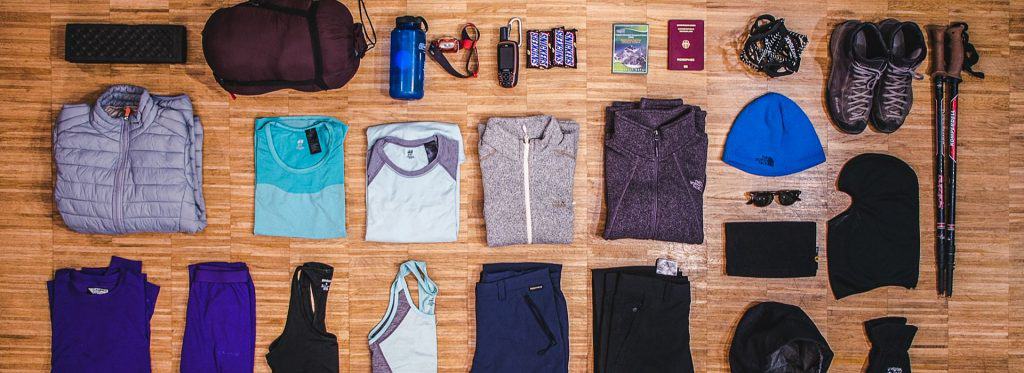
Of course, there may be more items you would like to pack. Everyone is different and has their own requirements. Check out our detailed and ultimate packing list for Everest Base Camp.
At what altitude is Everest Base Camp located?
The trek to Everest Base Camp starts at a height of 2840 meters in Lukla. Our final goal is to reach Everest Base Camp, which is situated at a height of 5,364 meters or 17,598 feet in Nepal.
Is it compulsory to trek to Everest Base Camp with a guide?
It is not mandatory to hire a guide to trek to EBC. However, we do not recommend trekking without one. Mosaic Adventures’ experienced guides are not just there to entertain and tell stories. They are there to guide you, prevent you from getting lost on the trail or going into dangerous areas. In addition, our guides are professionals who are prepared to deal with the typical weather changes of the mountains and assist you in case something goes wrong or you are hit by altitude sickness. Moreover, hiring a guide also helps the local economy and creates jobs.
Everest Base Camp trek price:
Our Everest Base Camp Trek price of USD 1445 is based on expenses for 14 days, which includes a 12-day trip to EBC with a return flight to Lukla. All you need to do is book your return flight to Kathmandu, and we will take care of the rest. The 14-day Everest Base Camp tour that we offer includes a 2-night stay in a hotel in Kathmandu, return flight to Lukla, most meals, a guide, porter, permit, etc.
How do I book the Everest Base Camp trek?
There are several websites where you can book your Everest Base Camp trek. However, it’s essential to consider that cheap providers may not treat their staff well and may cut prices wherever they can. In Nepal, the income is relatively low, and some organizations don’t think of sustainable long-term operation. At Mosaic Adventure, we pay fair wages to our guides, and we are proud of them. They are selected based on their knowledge, experience, and their respect towards local culture, people, and nature.
If you have any questions about the Everest Base Camp trek, why not get in touch with us? We are here to help you get to the Everest Base Camp!
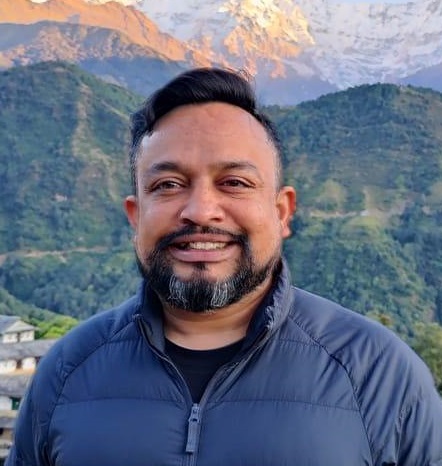
Raj is the co-founder of Mosaic Adventure who have immense knowledge of all the trail throughout Nepal. Working on the trekking industry for more than three decades Raj knows the country like back of his hands. If you need more information or help to plan any trips to Nepal, feel free to get in touch with Raj through his email [email protected] or whatsapp him on +9779851090836.

